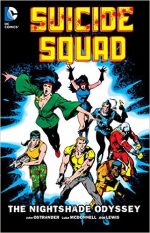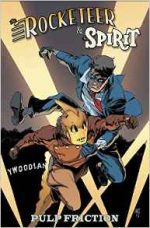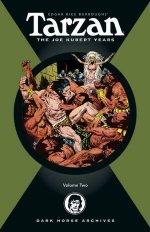
By John Ostrander, Keith Giffen, J. M. DeMatteis, Paul Kupperberg, Robert Greenberger, Luke McDonnell, Erik Larsen, Rob Liefeld & various (DC Comics)
ISBN: 978-1-4012-5833-7
In 1986, mega-monster continuity reboot Crisis on Infinite Earths led to DC Comics overwriting fifty years of continuity and revamping their major properties. The massive spring-cleaning exercise led to a swarm of boldly innovative titles and a fresh look at how comicbooks could be done.
One of the most unconventional – despite crossing genres and having roots leading back to the very dawn of the Silver Age – was Suicide Squad by John Ostrander and artist Luke McDonnell.
Previously during a psychological attack on the very concept of heroism (as seen in the miniseries Legends and its many tie-ins and crossovers) President Ronald Reagan outlawed costumed crimebusters and sanctioned an ultra-covert governmental black-bag operation to press super-powered criminals into (secret) service…
John Ostrander was new to DC; lured with Editor Mike Gold from Chicago’s First Comics where their work on Starslayer, Munden’s Bar and especially Grimjack had made those independent minnows some of the most popular series of the decade. Spinning out of Legends, Ostrander hit the ground running with a superbly compelling reinterpretation of the long-neglected Suicide Squad: a boldly controversial revaluation of meta-humanity and the role of government in a world far more dangerous than the placid public believed…
As originally conceived by Robert Kanigher, the Suicide Squad first saw action in The War that Time Forgot (Star Spangled War Stories #90, April-May 1960). Paratroops and tanks of “Question Mark Patrol†dropped onto Mystery Island from whence no American soldiers ever returned. The crack warriors discovered why when the operation was overrun by dinosaurs and worse…
Re-imagined for The Brave and the Bold #25 (September 1959) as a quartet of combat specialists, Colonel Rick Flag, medic Karin Grace plus boffins Hugh Evans and Jess Price were officially convened as Suicide Squad/Task Force X by the US government to investigate uncanny mysteries and tackle unnatural threats.
The gung ho gang (another Kanigher, Andru & Esposito invention) appeared in six issues but never really caught the public’s attention – perhaps because they weren’t costumed heroes – and quickly faded from memory.
Then, in April 1967 Our Fighting Forces #106 began the exploits of homicide detective Ben Hunter; recruited by the army during WWII to run roughshod over a penal battalion of prisoners who had grievously broken regulations.
Facing imprisonment or execution, the individually lethal military malcontents were given a chance to earn a pardon by undertaking missions deemed too tough or hopeless for proper soldiers. Hunter’s Hellcats – inarguably “inspired†by the movie The Dirty Dozen – ran until December 1969, in increasingly nasty and occasionally fatal sorties, before being replaced without fanfare or preamble by The Losers and similarly lost to posterity.
Ostrander tied together all these disparate strands and linked obscure comics events to provide a shocking secret history of America: a time when superheroes were forced into retirement after World War II with the military and Task Force X used to (unobtrusively) take out the monsters, spies, aliens and super-criminals who didn’t conveniently pack up with them.
Now substituting super-villains for simple criminals, history was made…
This second collection was designed to tie-in to both the TV and movie incarnations of the Suicide Squad. Reprinting Suicide Squad #9-16, plus a crossover from Justice League International #13, material from Secret Origins #28 and team-up one-shot Doom Patrol/Suicide Squad #1(spanning January-August 1988) – it resumes the story of strident political insider Amanda Waller who convinced President Reagan to sponsor her scheme to make bad guys do good deeds.
He agreed, but only as long as he had complete deniability…
Waller didn’t want society to depend on capricious super do-gooders and recruited Flag’s damaged, driven son to run a new penal battalion working “off the booksâ€, using state-sanctioned metahuman force for the greater good. Knowing criminals can’t be trusted, her devious set-up involves not just bribery – reduced sentences, financial favours and pardons – but coercion.
Field missions are led by traumatised, obsessively patriotic Flag Jr., assisted by amnesiac martial artist Bronze Tiger who ensures everybody stays honest and on-mission. Convict-operatives are picked as necessity demands, but some operatives are in regular use, such as Deadshot, Captain Boomerang and schizophrenic sorceress Enchantress. They are, however, wired with remote-detonation explosive devices just in case…
Backed by a support team which includes Flag’s former lover Karin Grace and Briscoe, a bizarre mystery pilot who has a rather unusual relationship with his seemingly sentient helicopter gunship, the ever-fluctuating team seem ready for anything…
The stories here come from a period when publishers were first developing the marketing strategies of the “Braided Mega-Crossover Event.†This hard-on-the-pockets innovation dictated really big stories involving every publication in a company’s output, for a limited time period – so a compilation like this perforce includes adventures that seem confusing because they are essentially “middles†with no beginnings or endings.
In this instance the unfolding epic is Millennium which saw writer Steve Englehart expand on an iconic tale from Justice League of America #140-141 as well as his run on the Green Lantern Corps…
Billions of years ago the robotic peacekeepers called Manhunters rebelled against their creators. The immortal Guardians of the Universe desired a rational, emotionless cosmos – a view challenged by their own women. The Zamarons eventually abandoned the Guardians at the inception of the grand scheme, but after eons apart the two factions finally reconciled and left our reality together.
Here and now they have returned with a plan to midwife a new race of immortals on Earth, but the mechanoid Manhunters – who had in the meantime infiltrated all aspects of every society throughout the cosmos – resolved to thwart the plan, whether by seduction, connivance or just plain brute force.
The heroes of Earth gathered to protect the project and confront the Manhunters in their own private lives… and their own comics…
Thus Suicide Squad #9 (by Ostrander, Luke McDonnell & Bob Lewis) sees a team assembled to destroy a Manhunter Temple deep in the Louisiana swamps surrounding the team’s secret Belle Reve base. However, as they battle their way in with a monolithic bomb – despite interference from Captain Atom, Firestorm and too-good-to-be-true reformed Manhunter Mark Shaw – Flag discovers the person he most trusted is a Manhunter mole…
An unlikely hero then pays ‘The Final Price’ to complete the mission before, unconventionally, the squad pick up a new recruit in the bellicose form of mystery warrior Duchess just as they flee the cataclysmic results of their latest covert triumph…
As counsellor/chaplain Reverend Cramer sets up shop in Belle Reve, a grievous security breach occupies Waller’s attention. Somehow Batman has penetrated the top-secret project and indignantly announces that he will expose the whole sordid show.
When neither Flag nor the squad are able to stop the Dark Knight, Amanda finds a unique way to make the intransigent hero back down in ‘Up Against the Wall’…
More politically astute action unfolds in ‘Red Pawn’ (plotted by Ostrander, scripted by Paul Kupperberg with art by Erik Larsen & Lewis from Doom Patrol/Suicide Squad #1) as reactionary right-wing hero Hawk is captured whilst running guns to anti-communist Contras in Nicaragua.
His plight quickly becomes the focus of a humiliating media circus, and, still smarting from his last press roasting for such illicit activities, Reagan orders Waller to rescue or kill the wayward freedom fighter.
Typically, this move angers the NSA advisors of the Leader of the Free World, who take matters into their own hands to fatally embarrass “the Wall†by inveigling recent Soviet defector Valentina Vostok to deploy her comrades in the Doom Patrol to save the tragic, well-meaning patriotic Hawk from the evil Sandanistas…
Already shaping up as a SNAFU of biblical proportions, neither American faction is aware that rival cabals in reformist Russian Premier Mikhail Gorbachev‘s vast espionage apparatus are also implementing their own undercutting agendas…
Soon the entire country is at war as the Squad battle the undercover Doom Patrol (Celsius, Robotman, Negative Woman and Tempest) until a brigade of armoured Rocket Reds invades the nation. With uncontrolled destruction at maximum, the pointless clash escalates even further as a fourth force comprising Soviet super-soldier Stalnoivolk and KGB master schemer Major Zastrow work their own malignant way towards an acceptable solution to restore the status quo …
Barely surviving the political fallout, Waller’s Wonders are next deployed to destroy a drug-cartel in Suicide Squad #11 as ex-Justice Leaguer Vixen seeks vengeance after her friends are gunned down during a smuggling operation. ‘Blood and Snow Part One’ sees her volunteer for the penal team which is starting to feel the pressure of its own success.
Flag is on the edge of a breakdown and nobody has noticed that incorrigible felon Boomerang is impersonating another super-villain to rob banks in his spare time…
With no time to assess and her best assets still in Nicaragua, Waller assembles a team heavy with government-affiliated heroes such as Black Orchid, Nightshade and Speedy to augment remaining regular players Captain Boomerang, Enchantress and Briscoe. With great misgivings she tasks them with infiltrating the inner circle of Medellin Cartel boss Xavier Cujo to destroy his jungle fortress and vast stores of cocaine.
None of them are particularly bothered by the fact that this is an official assassination mission…
Naturally, the plan is perfect up until the moment it begins and soon the undercover stalwarts are battling for their lives in the blistering conclusion ‘Blood and Snow Part Two’. In the ghastly aftermath, however, Vixen no longer counts herself as a hero of any description…
A crucial crossover began in Justice League International #13. ‘Collision Course’ (inked by Al Gordon, drawn by Keith Giffen and co-written with partner in comedic crime J. M. DeMatteis) revealed how US agent and Suicide Squad point-man Nemesis was being tortured in a Soviet jail: a fact proudly leaked by the State’s media…
He had languished there ever since Waller abandoned him at the end of a disastrous attempt to rescue Russian dissenter Zoya Trigorin, but when Batman learns his old ally is a political prisoner he determines to break him out with or without the help of his JLI associates…
At Belle Reve, Flag – unable to convince The Wall (who is being stonewalled by Reagan) that something must be done – has begun his own illegal attempt to free the American hostage. However, once again unseen Soviet machinations are in play and an ambitious plotter has gulled Russian hero Starfire to inject himself into the growing crisis to bait a devious trap…
Flag’s team then stumbles into and brutally clashes with Batman’s Leaguers who are eventually forced into the uncomfortable position of having to – at least ostensibly – fight to keep Nemesis in Russian custody as ‘Battle Lines’ (Suicide Squad #13 by Ostrander, McDonnell & Lewis) are drawn. With violence peaking everybody gets a grim lesson in superpower Realpolitik before a solution is found…
Dimension-hopping super-agent Nightshade has been working for the Suicide Squad in return for the promise of assistance in a personal task. Secret Origins #28 revealed her hidden history in ‘A Princess’ Story’ (Robert Greenberger, Rob Liefeld & Lewis), detailing how little Eve Eden escaped from her own arcane realm after it was conquered by a marauding mystic entity dubbed the Incubus, leaving her brother behind…
All her life she has trained; as a spy, a superhero and a warrior, readying herself for the moment when she would return to save her sibling and liberate her homeland…
These revelations lead into the eponymous story arc ‘Nightshade Odyssey’ which opens with the moment Waller always dreaded. A criminally corrupt senator has discovered the facts of the Suicide Squad and threatens to destroy Reagan’s legacy unless the team is used to end investigations into his malfeasance and get him re-elected.
A man of resolute convictions, the President immediately caves and orders Waller to get it done…
With The Wall seemingly broken and contemplating resignation, the beleaguered director tells Nightshade to complete her personal mission immediately. With barely a pause for thought Nightshade, Boomerang, Bronze Tiger, Deadshot, Duchess, Enchantress and Vixen are ‘Slipping into Darkness’ to materialise in a place of malign horror concealing a trap decades in the making…
From the mouth of her eternally corrupted brother, Eve learns the truth of the situation, the mystic history of the universes and the Incubus’ diabolical connection to the Succubus force which possesses Enchantress. Then she hears their repellent plans for her…
However the satanic corruptor has never met a fighter like the enigmatic Duchess, who provides a ferocious and world-shaking distraction, allowing Eve to free her comrades and effect an uncontrolled escape from the hellish dimension leaving the ‘Devil to Pay’…
Sadly, the pell-mell exit dumps the fleeing fugitives into an otherworldly ‘Deathzone’ (Suicide Squad #13, inked by Malcolm Jones III) between universes where they are doomed to madness and worse, until rescued by a mysterious alien nomad calling himself Rac Shade.
Holding information of a long-extant alien incursion on Earth, “the Changing Man†makes the jump back to Belle Reve where Amanda Waller has come to a momentous decision…
To Be Continued
With covers by Jerry Bingham, Larsen & Lewis, Steve Leialoha & Gordon and Jim Valentino, Keith Wilson & William Messner-Loebs, this is a timeless collection of gritty gripping, hard-edged Fights ‘n’ Tights forays to delight action fans: a still magnificent mission statement for the DC Universe, offering witty cohesive and contemporary stories that appealed not just to superhero lovers but also devotees of spy and crime capers. As such they remain fine fodder for today’s so-sophisticated, informed and thrill-hungry readers.
© 1988, 2015 DC Comics. All Rights Reserved.










